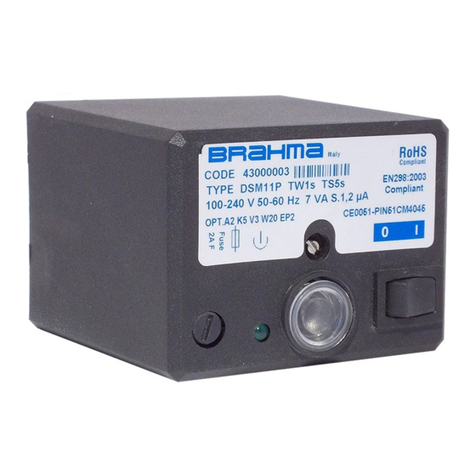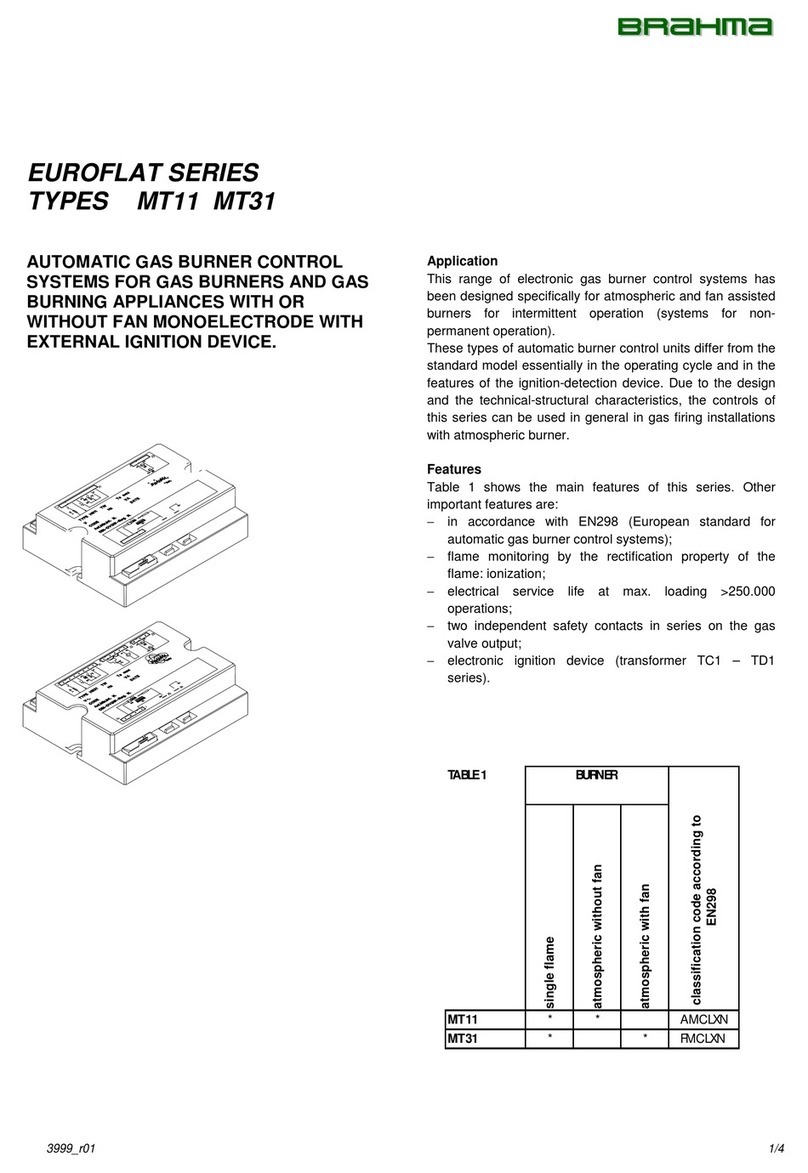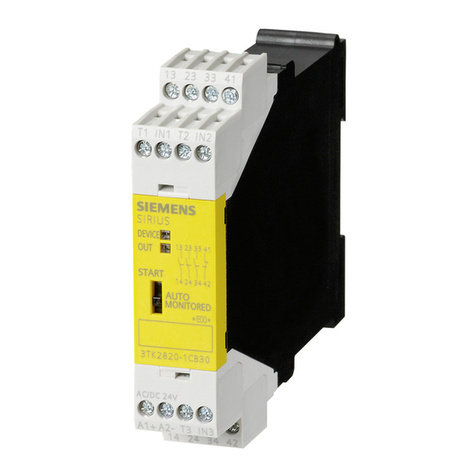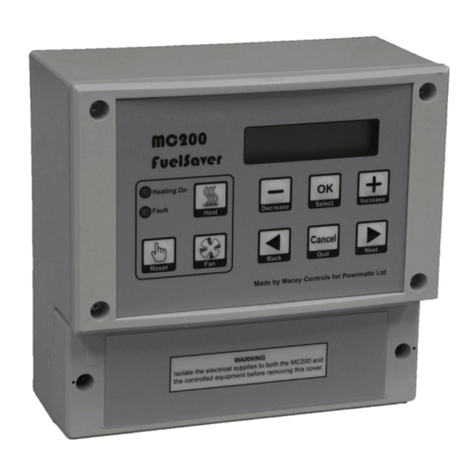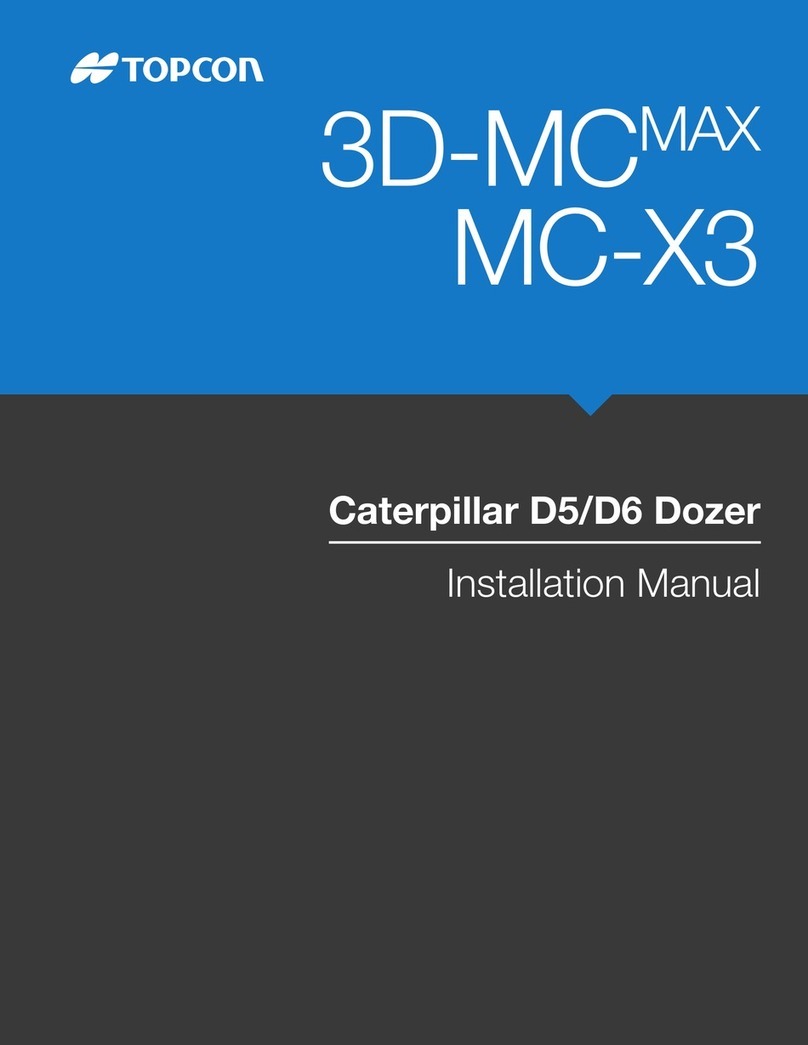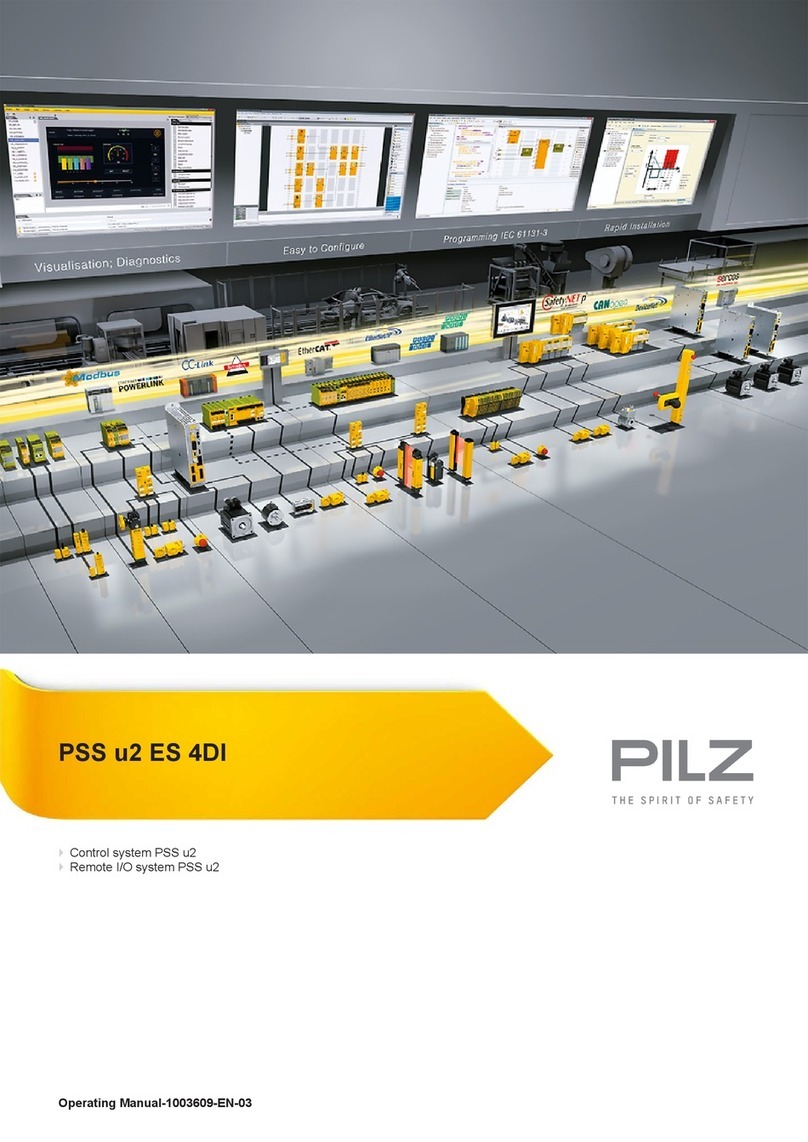BRAHMA MICROFLAT Series User manual

3997_r02 1/13
MICROFLAT SERIES
TYPES C...F S...F
M...F T...F
AUTOMATIC CONTROL SYSTEMS FOR
GAS BURNERS AND GAS BURNING
APPLIANCES WITH OR WITHOUT FAN
AND WITH BUILT-IN ANTI-EMISSIONS
FILTER
APPLICATION
This range of electronic gas burner control systems has
been specifically designed for atmospheric burners for
intermittent operation (systems for non-permanent
operation), with or without fan in the combustion circuit.
These controls are provided with both non-volatile lockout
and volatile lockout: in the first case restart from the safety
shutdown condition can only be accomplished by a manual
reset of the system; in the second case restart from the
safety shutdown condition can only be accomplished by an
interruption of the main power and its subsequent
restoration.
The automatic burner control units of this series are
suitable for:
-combi boilers;
-heating boilers;
-warm air generators;
-radiant heaters;
-water heaters.
Thanks to their design and variety of models, they can also
be used for the automation of ovens, cookers and in gas
firing installations with atmospheric burner in general.
FEATURES
Table 1 shows the main features of this series. Other
important features are:
− EC certification (CE Reg. N°0694BP0669) in
accordance with Gas Appliance Directives 90/396 and
93/68;
− in accordance with EN 298 (European standard for
automatic gas burner control systems and flame
detectors);
− completely solid and high efficient inbuilt ignition device
with built-in E.M. filter;
− possibility of mounting a resistor (0 ÷220 ohm) in series
to the valve output, in case the valves operate with
direct current obtained through the rectification of the
supply alternate current by means of one or more
diodes.
This resistor allows to reduce electromagnetic
disturbances generated by diodes switching;
− possibility of mounting a resistor (0 ÷470 Kohm) in
series to the lockout signal output, to avoid possible
damages to the control in case the connections of the
reset button and the connections of the lockout signal
are inverted;
− two independent safety contacts in series on the gas
valve output (only for non-volatile lockout types);
− auxiliary contact for low power ignition or main gas
valve control for intermittent pilot systems; this contact
is not isolated from the main supply voltage by
reinforced isolation, therefore the relay contact is not
suitable to supply SELV circuits - Safety Extra Low
Voltage, e.g.24V;
− flame monitoring by the rectification property of the
flame (ionization).

2/13 3997_r02
Table 1
Burner Features
Non-volatile lockout
Volatile lockout
Single flame
Dual flame
Atmospheric without fan
Atmospheric with fan
Monoelectrode
Auxiliary contact
Safety thermostat provision
Connector type molex
According to EN 298 :1993
According to EN 298 :2003
Classification code according to EN 298
CM11F
* * * * * * AMCLXN
CM12F
* * * * * * ATCLXN
CM31F
* * * * * * FMCLXN
CM32F
* * * * * * FTCLXN
SM11F
* * * * * * * ATCLXN
SM31F
* * * * * * * FTCLXN
MM11F
* * * * * * * AMCLXN
MM12F
* * * * * * * ATCLXN
MM51F
* * * * * * * * ATCLXN
MM31F
* * * * * * * FMCLXN
MM32F
* * * * * * * FTCLXN
TM11F
* * * * * * AMCLXN
TM12F
* * * * * * * ATCLXN
TM31F
* * * * * * FMCLXN
TM32F
* * * * * * * FTCLXN
CE11F
* * * * * AMCVXN
CE12F
* * * * * ATCVXN
CE31F
* * * * * FMCVXN
CE32F
* * * * * FTCVXN
SE11F * * * * * * ATCVXN
SE31F * * * * * * FTCVXN
ME11F
* * * * * * AMCVXN
ME12F
* * * * * * ATCVXN
ME51F
* * * * * * * ATCVXN
ME31F
* * * * * * FMCVXN
ME32F
* * * * * * FTCVXN
TE11F * * * * * AMCVXN
TE12F * * * * * * ATCVXN
NOTE
TECHNICAL DATA
Supply voltage: 220/240V @ 50/60Hz
On request:
110/120V @ 50/60Hz
Operatine temperature range: -20°C ÷+60°C
Ambient humidity: 95% MAX @ 40°C
Protection degree: IP 00
Times:
- prepurge or waiting time (TW):
1.5 … 40 s
- safety time (TS):
3 ... 120 s
- response time on running flame failure (TR):
<1 s
The times given on the burner control label correspond to the
values guaranteed. The actual values slightly differ from the values
given, pre-purge and waiting time is in fact longer and safety time
shorter than their nominal values.
Power consumption, at starting up:
types without burner 10VA
types with burner 12VA
Power consumption, running:
types without burner 7VA
types with burner 9VA
Contact rating:
- Thermostat: 4A cosϕ≥0.4
- VG1: 0.5A cosϕ≥0.4
- VG2: 0.5A cosϕ≥0.4
- Fan motor: 1A cosϕ≥0.4
- Lock-out signalling: 1A cosϕ= 1
- Auxiliary contact: 0.5A cosϕ≥0.4
Max. length of the cables of external components:
1 m
Internal fuse rating: 4A fast
External fuse rating: 3.15A fast
Flame control:
The ionization flame detection device makes use of the
rectification property of the flame.
The ionization flame detector device is not a safe to touch
output (no provision with protective impedances).
- Minimum ionization current: 0.5µA
on request:
1.2µA / 2.5µA
- Max ionization current @ 230V: 8.5µA DC
- Recommended ionization current: 3÷5 times the
minimum value
- Max. length of the cable: 1 m
- Minimum insulation resistance of the
cable and the flame
detector device to earth:
≥50 MΩ
- Max. parasitic capacitance of the
detection probe: ≤1 nF
- Max. short circuit current: <200µA AC
This contact is not isolated from the main supply voltage by
reinforced isolation, therefore the relay contact is not suitable to
supply SELV circuits – Safety Extra Low Voltage.
Safety thermostat opening causes cycle repetition and
volatile/non-volatile lockout.
Standard connectors are Stelvio-Stocko models, as shown in
Fig.2.
.
Flame failure durino TS causes spark restoration.
Device is compliant only if the note “EN 298:2003 compliant”
and the option “#” are report on the label.

3997_r02 3/13
Ignitor:
- Peak ignition voltage: 15KV con carico di
30pF
on request:
12/18 KV
- Peak current: 800 mA
- Spark repetition rate: 25 Hz
on request:
1 ... 8/10/12/16 Hz
- Max. length of the cable: 2 m
- Spark gap recommended: 2-4 mm
- Consumption: 2.5 VA
- Spark energy: 20 mJ
Weight: 170 g
CONSTRUCTION
The enclosure made of plastic material and the varnishing
of the circuit board protect the control from mechanical
damages, dust and dirt from the conditions of installation.
Through the use of a board assembled with surface
mounted components and of a new patented circuit
generating the ignition spark which limits the EM to a
minimum, it has been possible to reduce the printed circuit
board dimensions and to realize even the most complex
executions with extremely compact dimensions.
A varistor protects the control from voltage transient on the
main supply, caused for example by discharges such as
thunderbolds. An internal fuse protects the relays of the
control box in case of short circuits on the outputs (valves,
fan and lockout signal). In any case the control must be
protected with a fast blow external fuse suitable to the load
connected and never exceeding 3.15 A.
OVERALL DIMENSIONS
The control units of the MICROFLAT series can be
supplied in different executions but with the same
enclosure. The following figure (Fig. 1) shows the overall
dimensions of the controls.
CLIP TO
EXTRACT
THE INTERNAL
FUSE
Fig. 1
POSSIBLE FIXING
top: self-tapping screw UNI 6951AB 2,9x22
M3x22 screw UNI6107
bottom:
Screwplast self-
forming screw
ISO0003 F
3.5x13
Screwplast self-
forming screw
ISO0003 F
3.9x13
ACCESSORI
The control units are usually supplied with a kit of female
connectors and/or a reset button (see Fig.2 and Fig.3).
Do not fit terminals and female connectors of different
types.
RESET BUTTON
DRILLING PLAN
FEMALE CONNECTOR
TERMINALS
RESET
LOCK-OUT SIG.
NEUTRAL
Fig. 2
FEMALE CONNECTOR
TERMINALS
Fig. 3
CONNECTION
The use of non-reversible connectors with a different
number of poles makes the connection easy and reliable.
One-way fast-on connectors of different sizes for ignition
and detection electrodes permit their easy installation and
replacement.
The dual output ignition device allows spark generation on
one point (3a), two points (3b) or between two electrodes
isolated from the metal frame of the burner (3c), see Fig.4.
The configuration (3c) assures a limited EM emission.
Fig. 4
Provisions such as strain relieves, sufficient earth terminals
and neutral terminals should be present in the appliance or
in external connection boxes. With all types it is possible to
execute the connection with a J3 connector as shown in
Fig.5.
Types TM..F are prearranged for the connection of a safety
thermostat ST which stops the supply to the gas valve VG1
and causes a safety shutdown after a delay which is the
sum of waiting (pre-purge) and safety times.

4/13 3997_r02
(4a) W ith saf ty th rmostat (4b) Without saf ty th rmostat
Fig. 5
DIRECTIONS FOR USE
− For technical and safety reasons a regulation shutdown
must occur every 24 hours (systems for non-permanent
operation);
− automatic controls are safety devices and must not be
opened. The manufacturer’s responsibility and
guarantee are invalidated if the control is opened;
− the control must be connected and disconnected only
after switching off the main power;
− the control can be mounted in any position;
− avoid exposing the control unit to dripping water;
− ventilation and the lowest temperature ensures the
longest life of the control;
− make sure that the type (code and times) you are using
is correct before installing or replacing the control;
− the gas appliance on which the control is installed must
provide adequate protection against the risk of electrical
shock (at least IP20).
ELECTRICAL INSTALLATION
− The applicable national regulation and the European
standards (e.g. EN 60335-1/prEN 50165) regarding
electrical safety must be respected;
− live and neutral should be connected correctly, a
mistake could cause a dangerous situation, i.e. the
valves would still be live with the thermostats and limits
switched off. If live-neutral polarity is not respected the
control performs a non-volatile lockout at the end of the
safety time at starting up;
− before starting the system check the cables carefully.
Wrong connections can damage the control and
compromise the safety;
− the earth terminal of the control, the metal frame of the
burner and the earth on the main supply must be well
connected;
− avoid putting the detection cable close to power or
ignition cables;
− use a heat resistant cable for the detection probe, well
insulated to the ground and protected from possible
moisture (or water in general);
− use an ignition cable as short and straight as possible
and keep it far from other conductors to reduce the
emission of interference (max.length <2m and
insulation voltage >25KV).
In case of live-neutral network with unearthed neutral or
live-live network (with centre of the star not earthed) the
control can operate correctly by means of a built-in resistor.
In case of "partial" short circuits or bad insulation between
live and earth the voltage on the ionization probe can be
reduced until it causes the lockout of the control, because
of the impossibility of detecting the flame signal.
In the presence of this kind of network it is advisable to use
our step-up transformer type AR1.
CHECKING AT START
Always check the control before the first start and also after
any substitutions or a long period of non-operation of the
system. Before any ignition attempt make sure that the
combustion chamber is free from gas.
Then make sure that:
− if the starting attempt occurs without gas supply the
control performs a non-volatile lockout after TS;
− when stopping the gas flow while the control is in
running state the supply to the gas valve is interrupted
within 1 second, and after a recycling the control
proceeds to a non-volatile lockout;
− operating times and sequence are suitable;
− the level of the flame signal is sufficient, see Fig.6 for
the measuring test;
− the ignition probe(s) is (are) adjusted in the most
stable way for a spark gap between 2-4 mm;
− the intervention of limiters or safety devices causes a
safety shutdown according to the application.
Fig. 6
OPERATION
At every start the control unit proceeds to a self-checking of
its own components. During the waiting or prepurge time
(TW) the operation of the flame signal amplifier is checked:
the internal circuit makes a test of the flame signal amplifier
circuit. A parasitic flame signal or a fault in the amplifier
prevent the control from starting.
In the types with fan control, before the elapsing of the
prepurge time, the air pressure switch contacts are
checked to prove their "no air flow" state.
Only if the test is positive the fan is started and with the air
pressure switch in "air flow" state the prepurge time begins.
At the end of the waiting or prepurge time the VG1 gas
valve is energized and the ignition device is operated. In
this way the safety time (TS) begins. If the presence of
flame is detected during the safety time the ignition device
is inhibited and, in the suitable models, the main valve
(VG2) is supplied or the independent auxiliary contact will
switch from off to flame detected position.
On the contrary, if the control detect no presence of flame
by the end of TS, it proceeds to non-volatile lockout, the
VG1 gas valve and the ignition device are switched off
while the lockout signal output is supplied.
Flame failure during the safety time causes the ignition
device to be activated within one second.
The attached diagrams are useful to understand how each
control operates.
NON-VOLATILE LOCKOUT - RESET OF THE CONTROL
When a control has gone to non-volatile lockout, a ten-
second delay should be allowed before attempting to reset
the control unit; if this time is not observed the control may
not reset correctly.
VOLATILE LOCKOUT – RESET OF THE CONTROL
The restart from the safety shut-down condition can only be
accomplished by an interruption of the main power and it
subsequent restoration.
This types of burner control units do not contain an
independent manual reset function. The application of
these types of controls is therefore restricted to only those
appliances where resetting by switching off the heat
demand is allowed by European standards.

3997_r02 5/13
In general, resetting of the appliance must occur in sight
and in the near vicinity of the appliance. Resetting must
also occur by means of a conscious manual action and not
by means of automatic device like thermostats or timers.
Please note that it is allowed to combine the reset button
together with the main switch on the appliance. In this case
the alarm light will have to be installed too.
CONTROLS DENOMINATION
Type Options
(1) (2) (3) (4) F (5) (6) (7) (8) (9) (10)
(11)
(12)
(13)
Types description
(1) Installations
C
Wall boilers
S
General uses
M
Monoelectrode
T
With safety thermostat
(2) Reset
M
Manual
E
Electrical
(3) Type of burner
1 Without fan
3 With fan
5 Special types
(4) Gas valves
1 Single flame
2 Dual flame
Options description
(5) Compliance
According to EN 298:1993
# According to EN 298:2003
(6) Kind of connectors
Stocco-Stelvio connectors
X
Molex connectors
(7) Internal fuse
Not-accessible internal fuse
F Accessible internal fuse
(8) Resistor in series with VG2
Not present
W
Present
(9) Resistor in series with VG1
Not present
V
Present
(10) Protection against the inversion of the connections of the lockout signal and the connections of the reset button
Not present
R
Present
(11) Protection against air pressure switch reversal connection
Not present
P
Present
(12) Ignition coltage
15 Kv (standard)
H
18 kV
L 12 kV
(13) Spark repetition rate
25 Hz (standard)
nn Number represents the discharge frequency

6/13 3997_r02
CONNECTION DIAGRAM
TYPES WITH MANUAL RESET WITHOUT FAN
THERMOSTAT FUSE BURNER LOCK
-OUT FIRST GAS SECOND GAS SAFETY RESET MAIN
SIGNAL VALVE VALVE THERMOSTAT SWITCH
TYPE CM11F
TYPE SM11F
TYPE MM11F
TYPE TM11F
TYPE MM51F
TYPE CM12F
TYPE TM12F
TYPE MM12F
NOTA: the limit thermostat has to be wired in series to the live.

3997_r02 7/13
TYPES WITH MANUAL RESET AND FAN
THERMOSTAT FAN AIR PRESSURE FUSE BURNER LOCK
-OUT FIRST GAS SECOND GAS SAFETY RESET MAIN
SIGNAL VALVE VALVE THERMOSTAT SWITCH
TYPE CM31F
TYPE SM31F
TYPE MM31F
TYPE TM31F
TYPE CM32F
TYPE MM32F
TYPE TM32F
NOTA: the limit thermostat has to be wired in series to the live.

8/13 3997_r02
TYPES WITH ELECTRICAL RESET WITHOUT FAN
TYPE CE11F
TYPE SE11F
TYPE ME11F
TYPE TE11F
TYPE CE12F
TYPE ME51F
TYPE ME12F
TYPE TE12F
THERMOSTAT FUSE BURNE
R LOCK-OUT FIRST GAS SECOND GAS SAFETY MAIN
SIGNAL VALVE VALVE THERMOSTAT SWITCH
NOTA: the limit thermostat has to be wired in series to the live.

3997_r02 9/13
TYPES WITH ELECTRICAL RESET AND FAN
TYPE CE31F
TYPE SE31F
TYPE ME31F
TYPE TE31F
TYPE CE32F
TYPE ME32F
TYPE TE32F
THERMOS
TAT FAN AIR PRESSURE FUSE BURNER LOCK
-
OUT FIRST GAS SECOND GAS SAFETY MAIN
SIGNAL VALVE VALVE THERMOSTAT SWITCH
NOTA: the limit thermostat has to be wired in series to the live.

10/13 3997_r02
OPERATING CYCLES
TYPES WITH MANUAL RESET WITHOUT FAN

3997_r02 11/13
TYPES WITH MANUAL RESET AND FAN

12/13 3997_r02
TYPES WITH ELECTRICAL RESET WITHOUT FAN

3997_r02 13/13
TYPES WITH ELECTRICAL RESET AND FAN
THERMOSTAT FAN AIR PRESSURE
SWITCH IGNITION FLAME
SIGNAL LOCK-OUT
SIGNAL FIST GAS
VALVE SECOND GAS
VALVE AUXILIARY
CONTACT SAFETY
THERMOSTAT
TYPE CE31F - ME31F TYPE TE31F
TYPE CE32F - ME32F TYPE TE32F
TYPE SE31F
BRAHMA S.p.A.
Via del Pontiere, 31
37045 Legnago (VR)
Tel. +39 0442 635211 - Telefax +39 0442 25683 07/04/04 Subject to amendments without notice
http://www.brahma.it
E
-
ATTE
N
TION
-
>
Company
Brahma S.p.A.
d
e
c
l
i
n
e
s
a
n
y
respons
i
bilit
y
f
o
r
a
n
y
d
a
m
a
g
e
r
e
s
u
l
t
i
n
g
f
r
o
m
t
h
e
C
u
s
t
o
m
e
r
’
s
i
n
t
e
r
f
e
r
i
n
g
w
i
t
h
th
e
de
vic
e
.
This manual suits for next models
32
Table of contents
Other BRAHMA Control System manuals
Popular Control System manuals by other brands
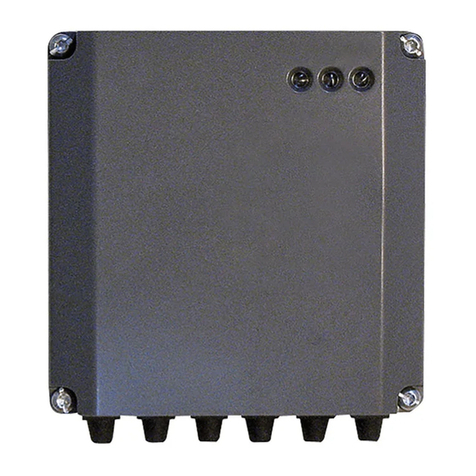
Ariston
Ariston Chafforeaux elco 3319130 Assembly and operation instructions

Norac
Norac UC5 Topcon X30 installation manual

Lifebreath
Lifebreath max series Homeowner's guide
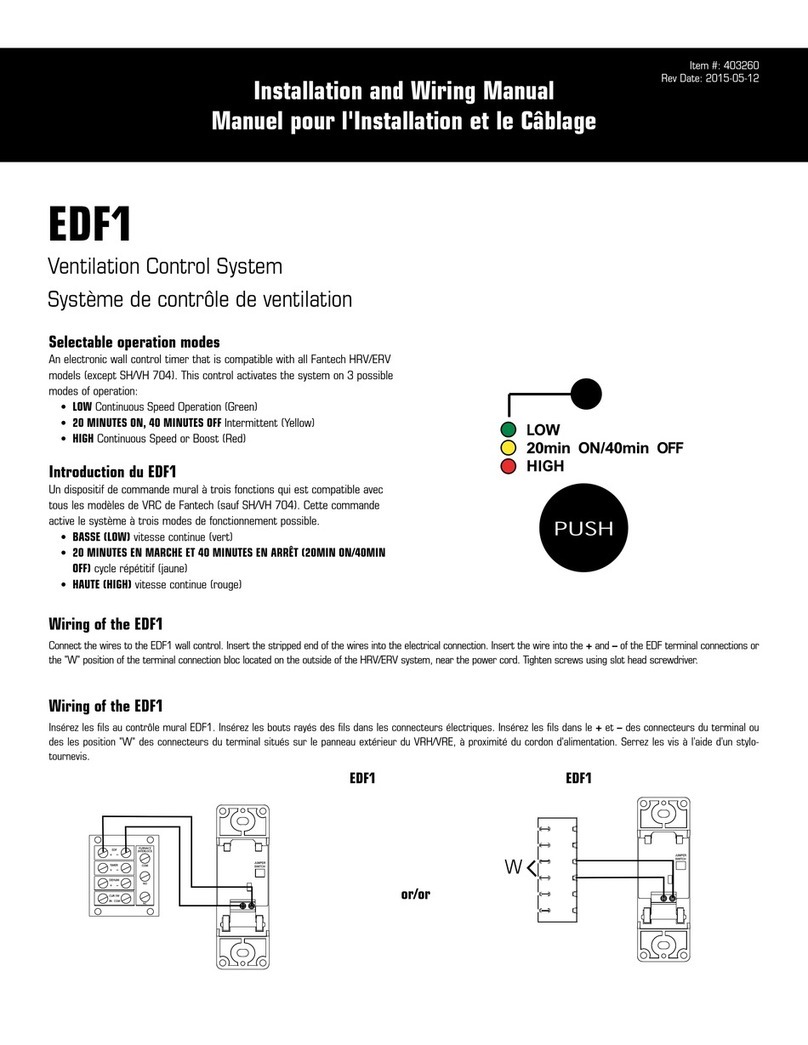
Fantech
Fantech EDF1 Installation and wiring manual
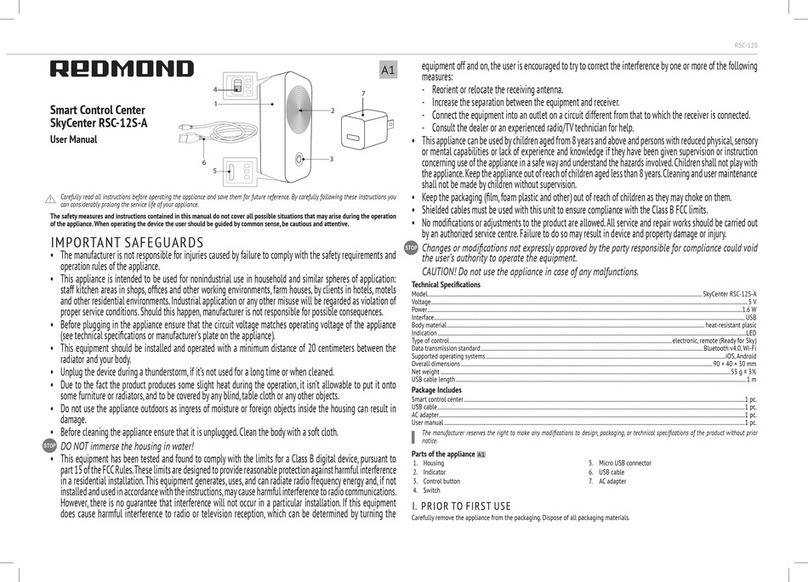
Redmond
Redmond SkyCenter RSC-12S-A user manual
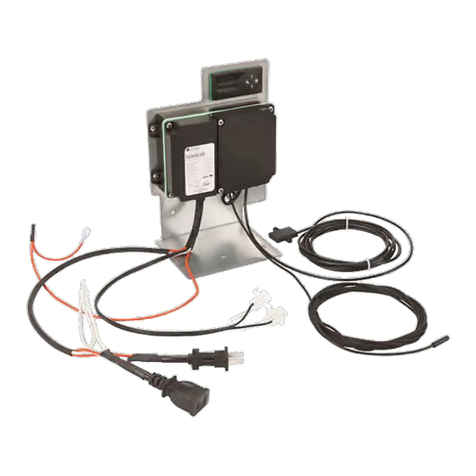
Elstat
Elstat ems75vr Installation and user guide
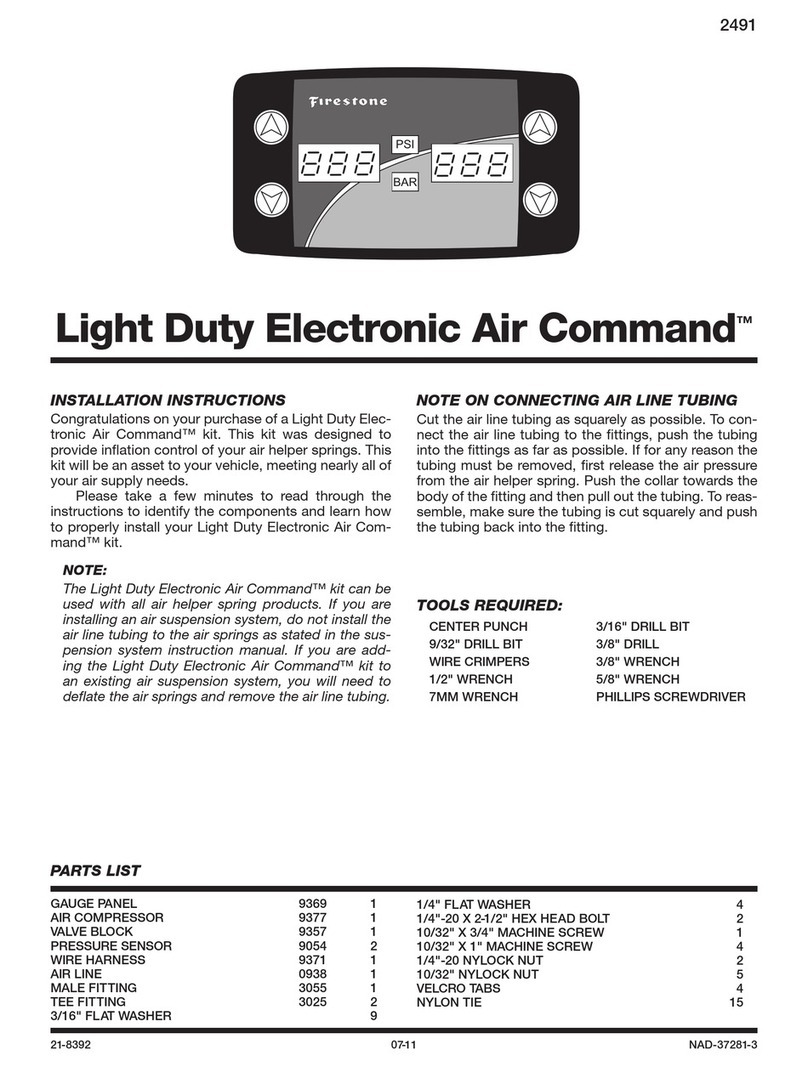
Firestone
Firestone 2491 installation instructions
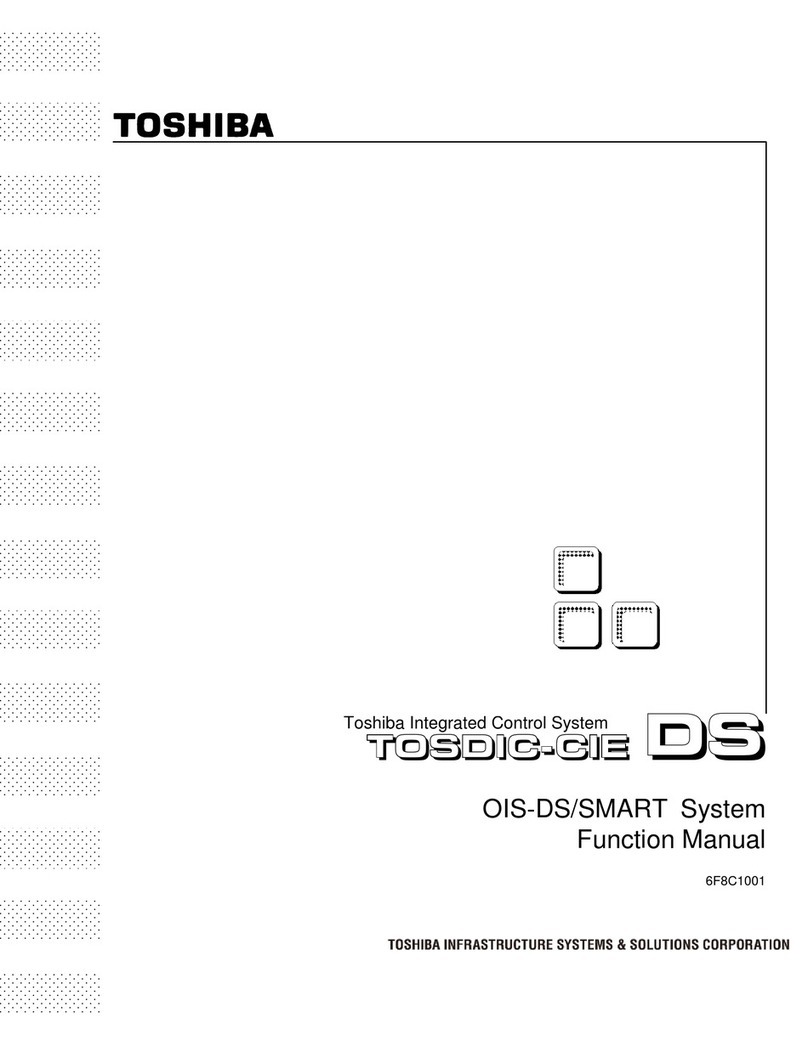
Toshiba
Toshiba TOSDIC-CIE DS Function manual
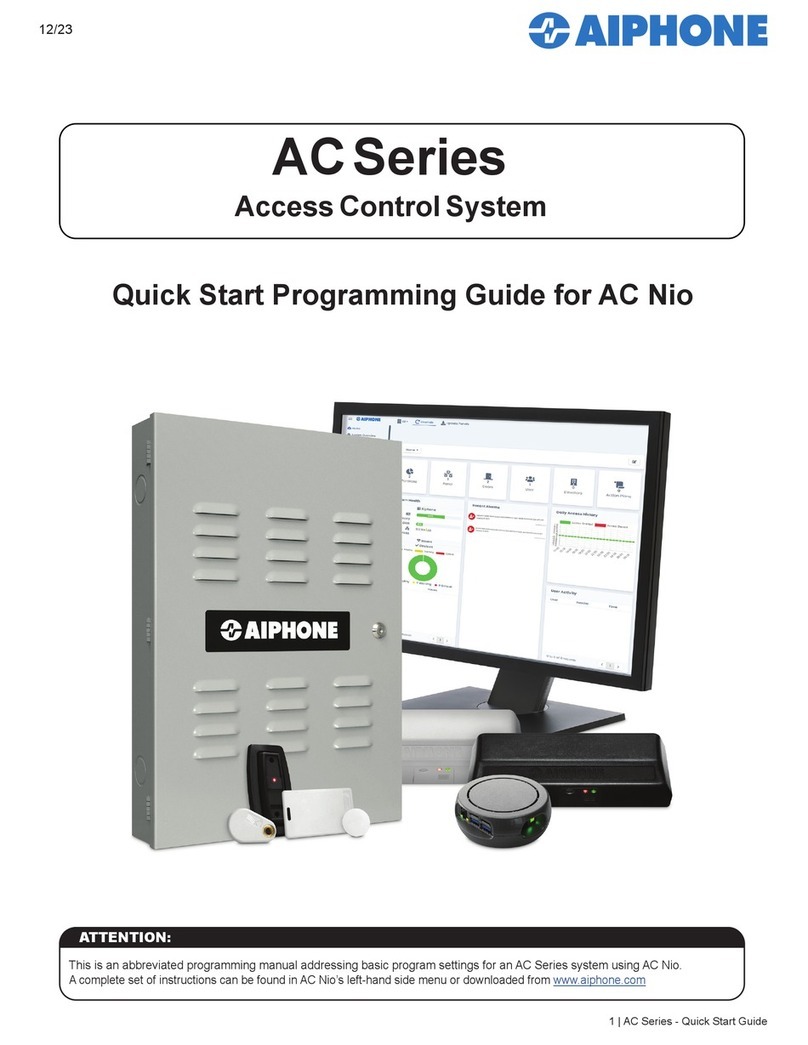
Aiphone
Aiphone AC Series Quick start programming guide
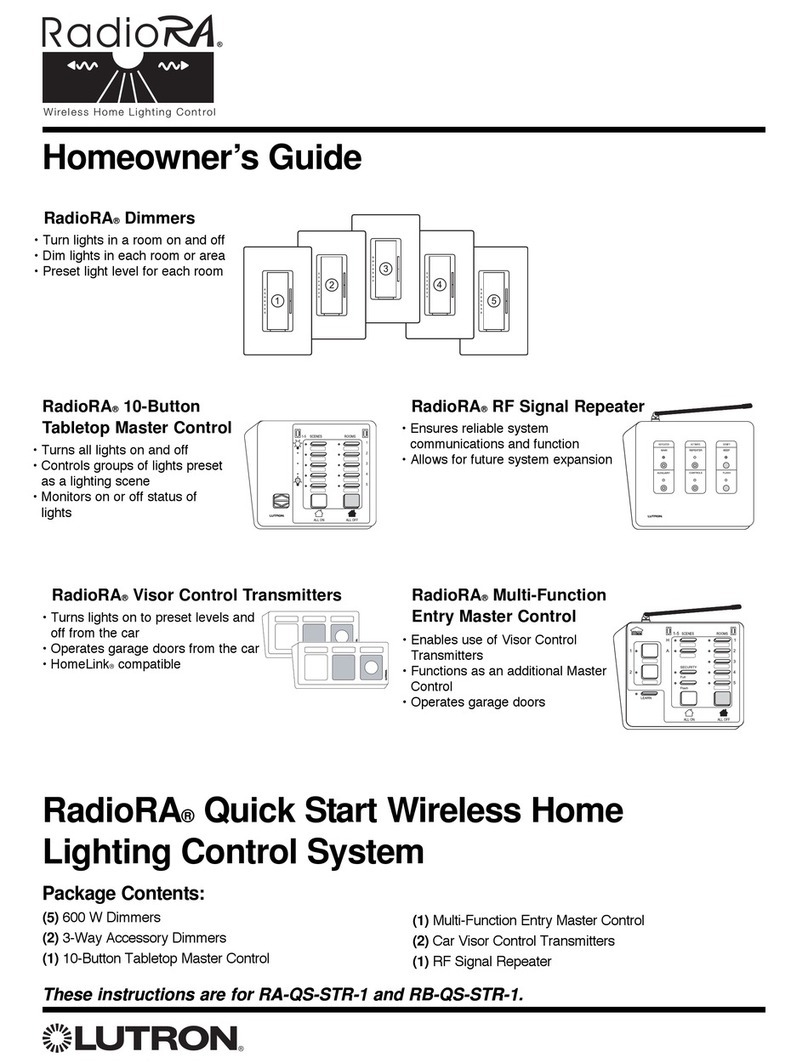
Lutron Electronics
Lutron Electronics RadioRA Homeowner's guide
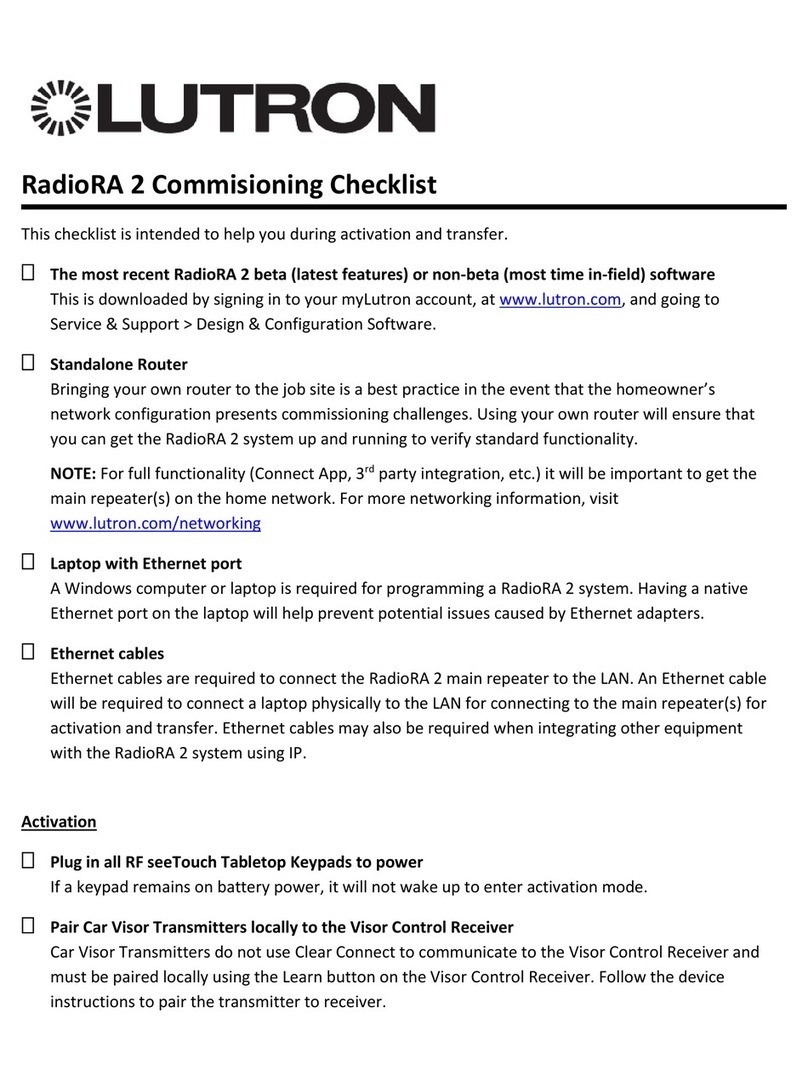
Lutron Electronics
Lutron Electronics RadioRA 2 Commisioning Checklist

Schaudt
Schaudt Electroblock EBL 271 instruction manual

